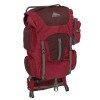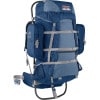Backpack
Make sure you take a comfortable, well fitting pack with you to Philmont. There are two types of backpacks on the market: Internal Frame and External Frame packs. If you ask any backpacker they will tell you the type of pack they have is the best. You need to find out is which pack feels more comfortable to you. Any local sporting goods store will fit you and let you try on both packs. Make sure you load a realistic amount of weight in it so you can really feel how the pack fits. If you don’t know how much your gear weighs, load at least 30 or 40 pounds of weight in it.
A good backpack, if well taken care of, is an investment that will take care of you on the trail for years to come. For scouts who are not done growing yet, buy a pack that will allow adjustments for growth. Most packs on the market today will do this.
The backpack you take to Philmont should be 65 liters (4,000 cubic inches) or larger. After you fit your pack you should only feel weight should on your hips and the front of your chest. There should not be any weight on the top of your shoulders.
Both Osprey and JanSport provide unconditional lifetime warranties on their gear. If you break it, they fix it for free or give you a new pack. It makes this the last pack you will need to purchase. Manufacturers like Kelty and Gregory provide great customer service, but they will have a reasonable charge for repairs.
Internal Frame
Packs are the most commonly used packs at Philmont. Over 95% of the Ranger department uses them. They are way more comfortable than external frame packs. They are designed to keep weight close to your back and at your normal center of gravity. Internal frame backpacks have straps which both compress your gear and bring it closer to your back. This means the pack fits more naturally on your back and has less chance of making your fall backwards. Everything stows on the inside. The heavier you load your pack, the less comfortable it will be. Internal frame packs are not designed to carry gear on the outside. They usually have places to anchor straps to, but it typically does not make for a natural pack feel. Most internal frame packs have only one top entrance. Beware of front zipper access that is not reinforced as it is likely the zipper will fail.
External Frame
Packs have a rigid frame on the outside of the pack,. They hold their shape and provide the same fit regardless of the load. They usually have lots of zippers and lots of pockets to keep your gear organized. You can strap gear to the outside of your pack pretty easily too. External frame packs will naturally place weight further away from your back and higher than your natural center of gravity which means if you don’t pack it right you will be back heavy. The width of the frame and external pockets, especially the zippers have a tendency to catch on branches and bushes as you hike. A huge plus is that external packs typically cost less than their internal frame counterparts.







